The Next Fest games keep on coming.
The games covered:
The Flipside of Gaming
The Next Fest games keep on coming.
The games covered:
ZoomZike’s back with another epic-length exhaustive examination of the hidden mechanics and math behind a Mario Party title, this time the Wii game Mario Party 8. At three hours and 34 minutes it’s not as long as the nearly five-and-a-half hour video on Mario Party 7, but it’s not any less detailed.
I can’t think of any more detailed descriptions of the hidden mechanics of such a complex game as these. The time and effort it takes to make them suggests mania on the part of the creator, but I’m still glad they do! It’s fascinating the care that these apparently-chaotic games were made with, and how their secrets were discovered by attentive players. I suggest not watching it all in one sitting, but in segments over several days. If you care about the subject at all, that is. But as should be evident, I do care, and I think you might as well if you’re interested in game design and give it a chance.
Identifying Luck in Mario Party 8 (Youtube, 3h 34m)
This is only incidentally about video games, but games are frequently advertised on Youtube.
You might have noticed a particular Youtube ad that, for whatever reason, you might want to make a record of. Or you want to watch it again to get details; maybe you want to save a local copy with youtube-dl or yt-dlp for some purposes, maybe to remix. Or maybe for some reason even vote on it, or leave a comment on it.
A secret fact about Youtube ads is that they’re all secretly just normal Youtube videos that have been registered with the ad system to put them into rotation. Every video you see on Youtube has its own 11-character ID, and ads are among them. If you know an ad’s ID, you can load it like any other video by putting it after the string:
https://youtube.com/watch?v= in the URL.
How can you get an ad’s ID? When it’s playing, pause it (one of the few things you can do in the player when an ad is being shown), then right-click the video and select Stats For Nerds.

That will get you various bits of troubleshooting information about the video currently being played:
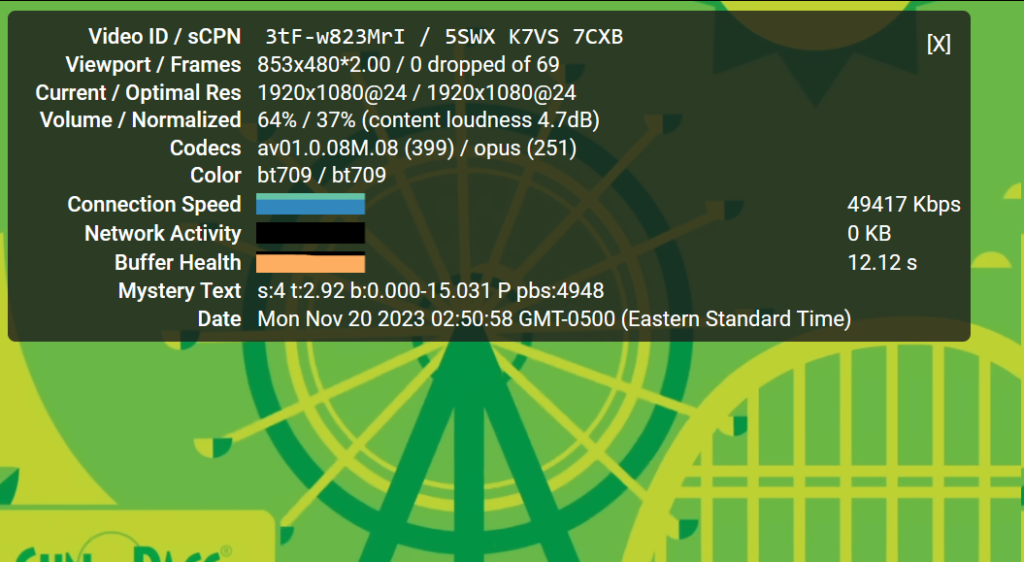
Where it says Video ID/ sCPN, that code after it, that’s the ad’s ID! That’s the code you paste at the end of the URL line to get to the video’s landing page. You can select it right out of the info box with the mouse and copy it to the clipboard with CTRL-C:
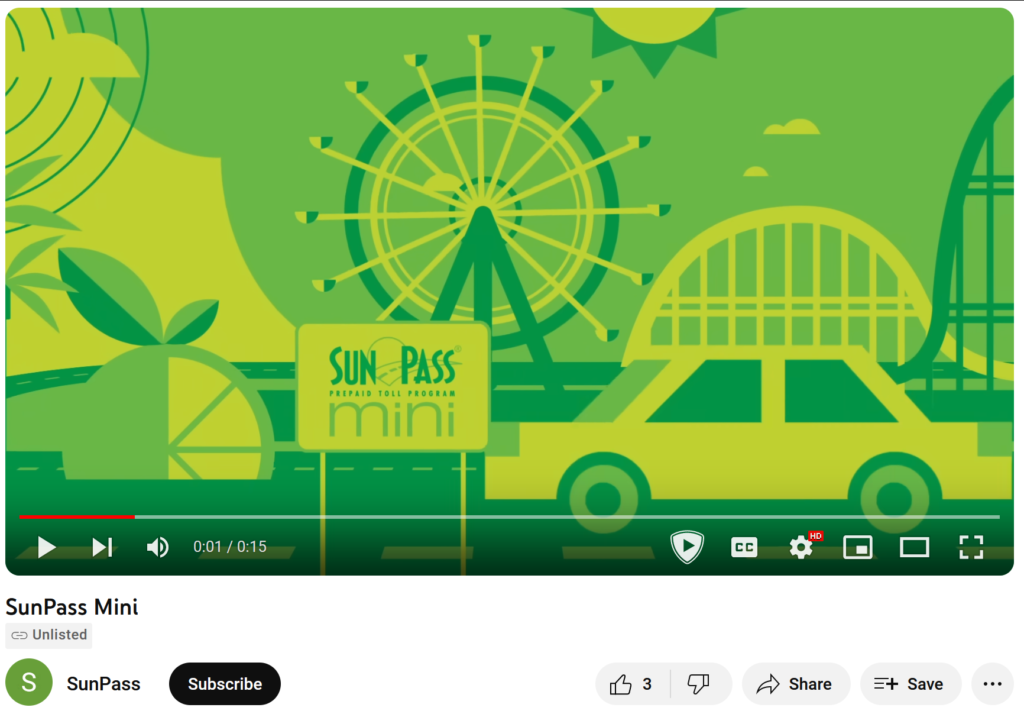
Notice, the ad video itself is unlisted. It isn’t always, but it’s rare for an ad to appear in Youtube’s discover interface anyway. Also, this video doesn’t have voting disabled. It’s off the bottom of the screen here, but its comments are even open. An amusing aspect of this is, before I got to watch this ad as a normal video, Youtube served me a different ad immediately before it.
Because of this, if you find a silly, ridiculous or awful ad, you can find its page on Youtube and watch it again, tell others about it, sometimes even leave comments that probably no one will ever read.
For example. Here’s an infamous video that made the rounds some months ago. “Give this man seven seven draws!” (The caption says 777 draws.)
It’s been labeled as unlisted and comments are turned off, but they didn’t bother to mark the video as non-embeddable. The ad campaign is over I think, but the video is still on Youtube, where it could possibly stay until the sun grows dim. The page says it’s currently been seen 3.6M times but it has no vote score, so it seems that getting served as an ad increases its view count.
This video, with the descriptive name “MLV109 EN 1920×1080 PC,” promoting the game “Grand Mafia” showcases the adventures of a poor Level 1 Crook, who’s constantly being turned down in his sudden marriage proposals to Hot Babes and Ex-Girlfriends because his level is low compared to the high level types that he’s surrounded by.
Hero Wars has been a heavily advertised game for months, sometimes with pretty gross ads. Badly animated blue hero guy is constantly injured by all the monsters and gods in his dumb generic fantasy world because he never went to school and learned about the important math concept of greater than. Because of that, his girlfriend got turned into a toilet and smashed to pieces. Stay in school, kids!
I’m trying to ease up on Youtube links, which I’ve come to realize take up a lot of the content of this blog by weight. I probably won’t be too successful at this, as it’s become a lot harder to find interesting written content on the internet, though it was never really easy.
I’ve been playing a lot of F-Zero 99 lately. I’ve been working on posts introducing the game, which is really great I think, but that kind of content (ugh the C word) takes time to write and check.
So in the meantime, enjoy/cringe at this collection of fun, and bad, handles spotted in the game. Of course, such a determination of quality is inherently subjective. But I think you’ll find that its lack is easier to adjudicate.

Obnoxious names, much less in number thankfully:
F-Zero 99 is not a fitting stage for such lusers. Get out of here with that sub-Sephiroth378 crap.

Note: while Nintendo continues to gamely update their blocklists to prevent newly-discovered ways to express slurs, they aren’t perfect, and I’ve seen a couple of outright offensive names. Those don’t even get the dignity of being present in my list of bad handles.
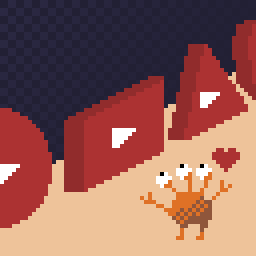
Sundry Sunday is our weekly feature of fun gaming culture finds and videos, from across the years and even decades.
Usually Sundry Sunday is for things related to games, not games themselves, but this is fun and random so why not?
The WarioWare people have made some weird games. Nowadays they seem to be focused on realizing the software products of Mario’s moneygrubbing alter ego and his disreputable gang of sorta-friends, but they have another series, Rhythm Tengoku, known in (some) English speaking territories as Rhythm Heaven.
Every single Rhythm Heaven game is a joy, from Karate Man to the Final Remix, but my favorite is probably Packing Pests, a.k.a. Pest Protectors.
Your onscreen surrogate is Employee 333-4-591032, working for the suspiciously-named Spider-Free Candy Company. And, well, see for yourself (three minutes):

No Rhythm Heaven mini game is much explained beyond its directions, but all of them tell a story by their details. Your character is a new hire. We know he works for Spider-Free Candy by the poster on his wall when the Wii version is played in widescreen. We know he’s creeped out by spiders by what happens if you accidentally clutch one or let one by your guard. And going by their faces we know the spiders try to leap into the box out of a manic kind of joy. They aren’t hostile! They just live to give you a hug, and to leap into boxes so as to give random other people hugs! Sadly, the demands of capitalism, and by that those of your paycheck, are to deny them in their life’s purpose.
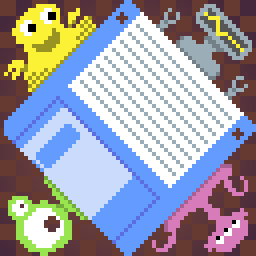
We love it when we find weird and unique indie games to tell you all about! Our alien friends to the left herald these occasions.
EDIT: there was a WordPress display glitch that was causing images to overlap the text. I’ve changed the formatting a bit to keep it readable.
There’s hundreds of new games released every day, and there’s no way to can even find out what they all are, let alone try all of them. So there’s an inescapable element of randomness to what meets my eyes, and thus to what I bring to you. It’s useless to ask, “Why did you link to that silly little trifile when Important Game by Known Developer goes without remark?” Our finds are always going to be kind of idiosyncratic.
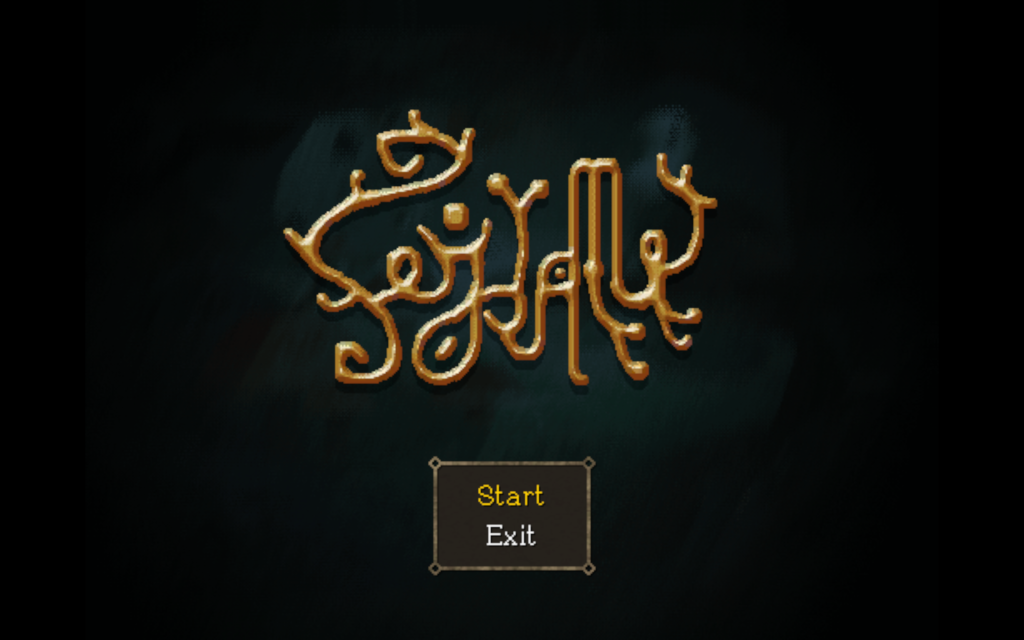
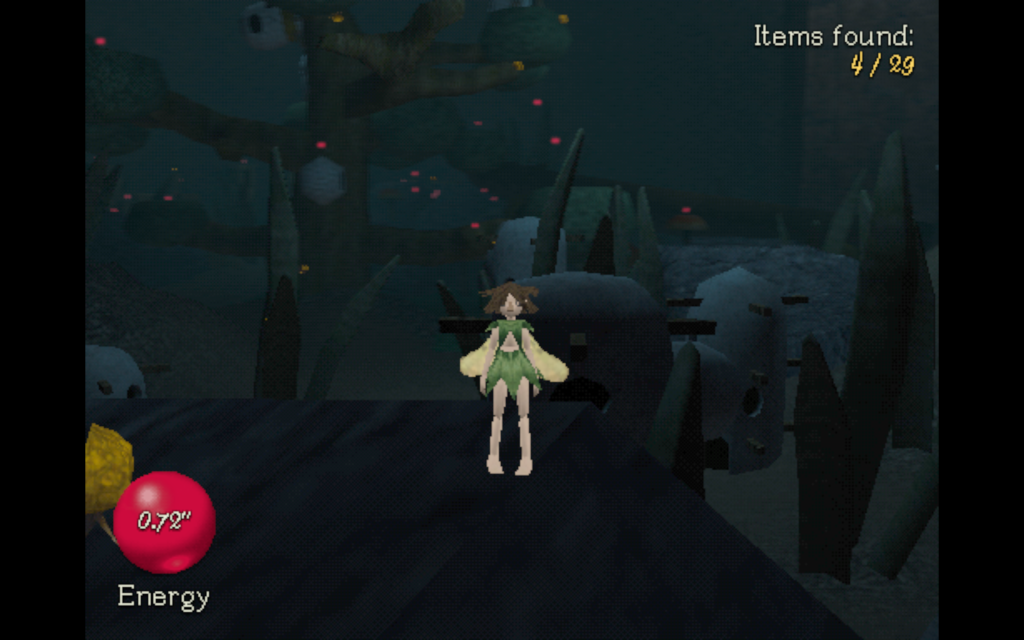
So it is with this one, Feydome, a slight but fun game made in two weeks for a game jam. It’s a laid-back 3D exploratory experience where you’re a barely-garbed, at first, fairy, searching an eerie abandoned village for clothes to wear. Movement is by WASD, with the Q and E, or else the left and right arrows, rotating the camera. Yes, it’s an exploratory dress-up game!
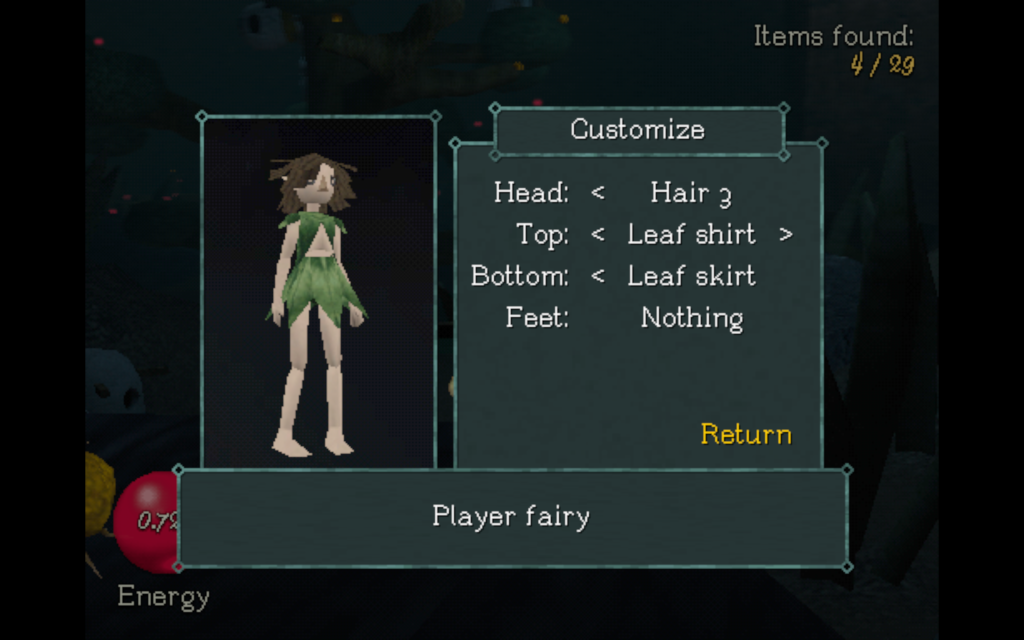
At the start your fairy is weak and can barely fly at all. You find glowing orbs that each grant a tiny bit more wing stamina, but never enough that you can fly indefinitely. Each orb very slightly extends the amount of flight time, by around one or two frames. So you’re always tied to the ground, but there are a lot of orbs to find, and that extra time adds up.
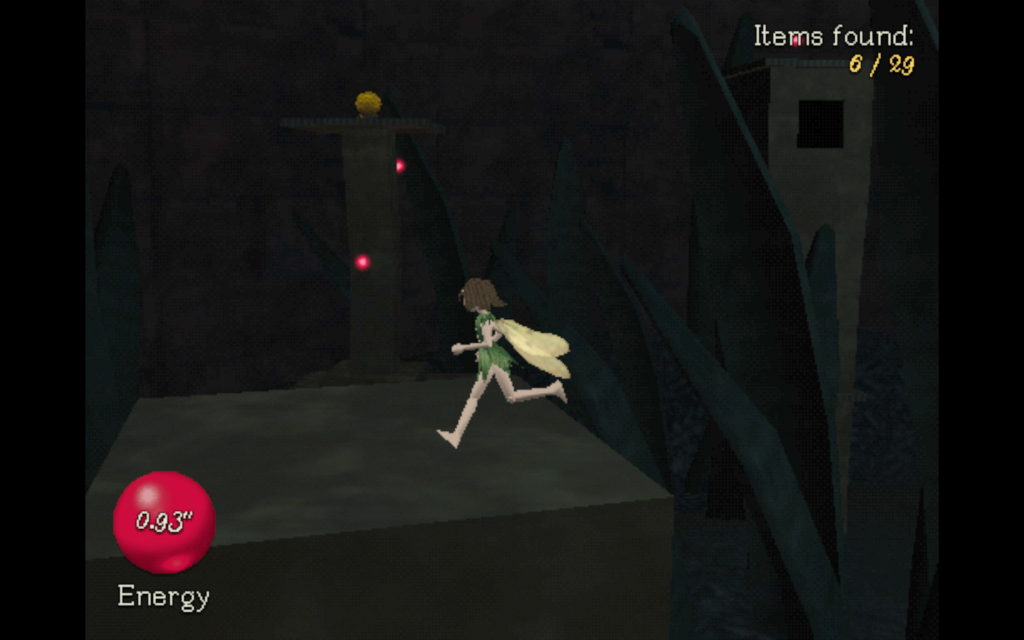
The fairy can glide if you hold the fly button down, even when out of energy, and if you keep tapping the space bar you can glide much further, which is a huge help. It helps to devote one hand to this, while using the other to move forward.
While you can rotate the camera, you can’t adjust the angle vertically, so you can’t look above or below, and there is no mouselook. The developer says that an expanded version is being made, maybe these control oversights will be addressed in that.
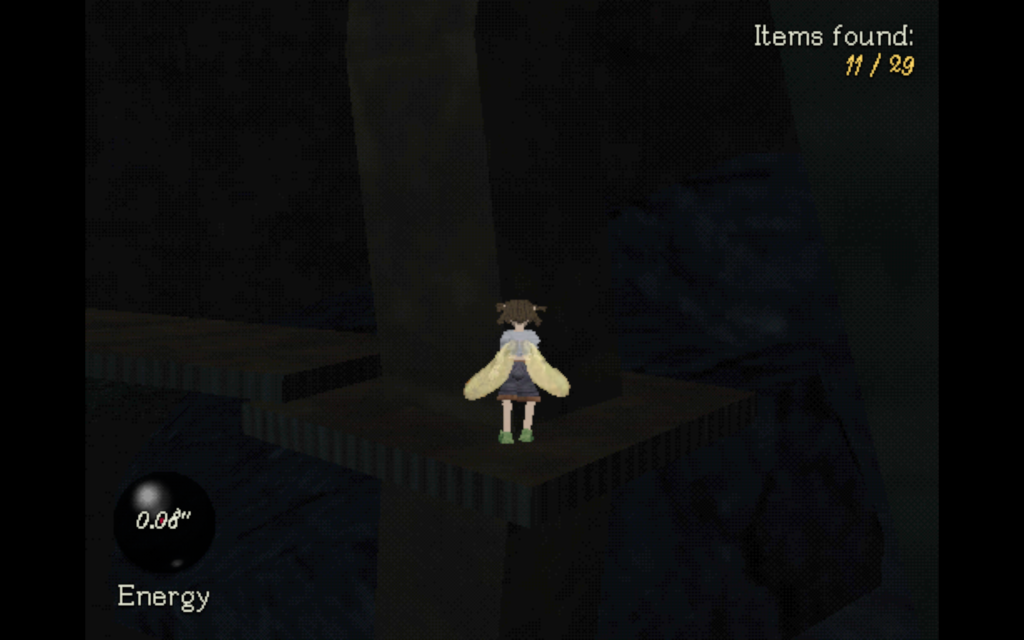
The pieces of clothing, 29 in all, are in weird chattering spheres that are stuck all over to the walls, floors and ceilings. When collected, a sphere stops chattering, which is of great help in tracking down the last few. Clothes go into your Customize Menu. You start out with just a Tied Fiber top and Leaf Panties bottom, but each item you find helps to make your wee friend more presentable in polite society (if there were any in this game).
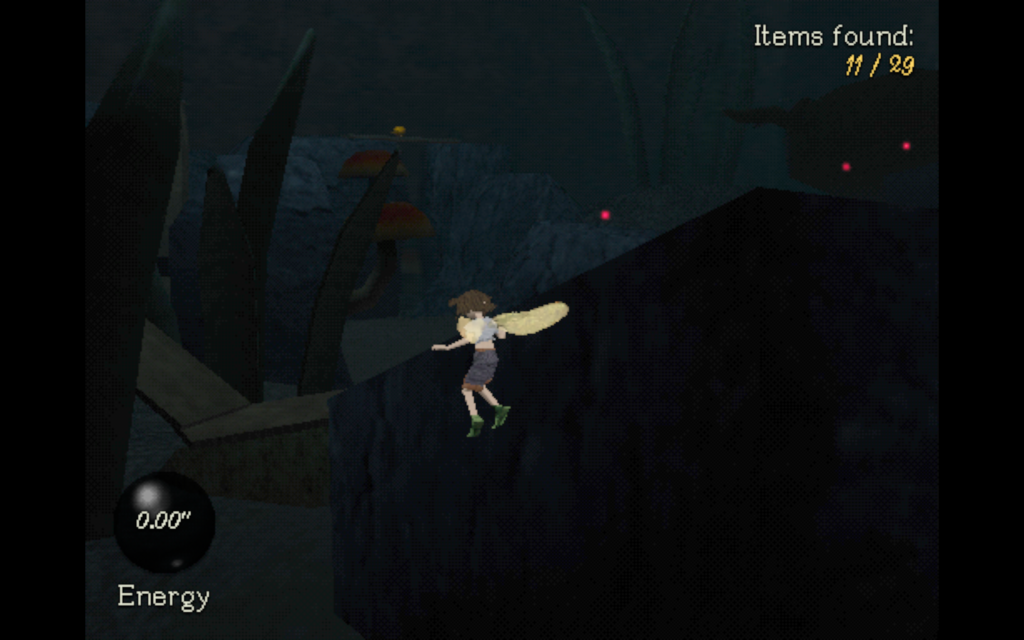
There are no enemies, and no moving objects besides the fairy. While it’s difficult to get around at first, it’s surprising how even an extra half second of flight time expands their horizons. Mind you, there is no reward for finding all of the clothing. There is no ending; the journey is entirely the point with Feydome. You’re left alone in the abandoned world, you and your wardrobe, until you exit the game. There’s no save function either, but the game’s so short that it can be finished in one sitting anyway. Maybe 40 minutes in all, if you focus on finding everything.
But it’s fun to explore! It’s a satisfying gameplay loop, finding orbs, using the extended flight time to find yet more orbs, and punctuating the process with occasional new clothes. I’m sure this kind of gameplay has been done before, but this is a neat example of it, and it doesn’t cost anything to try.
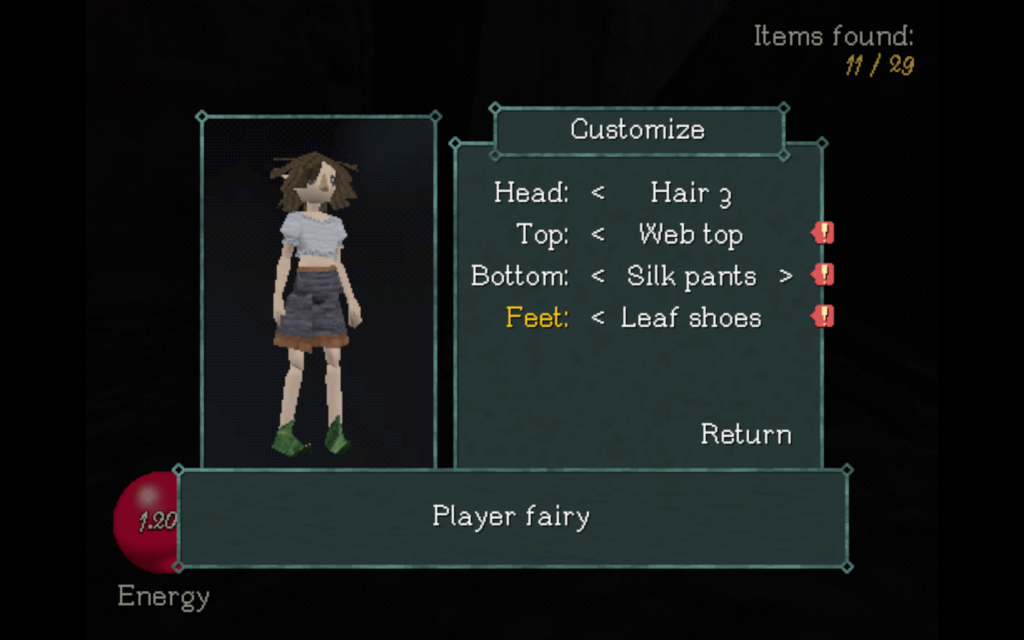
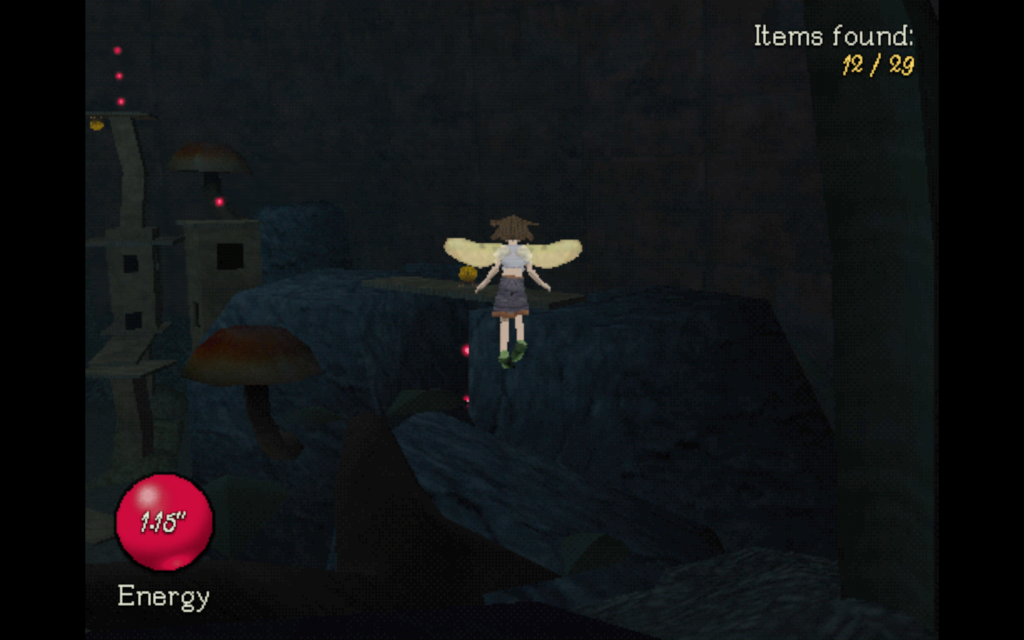
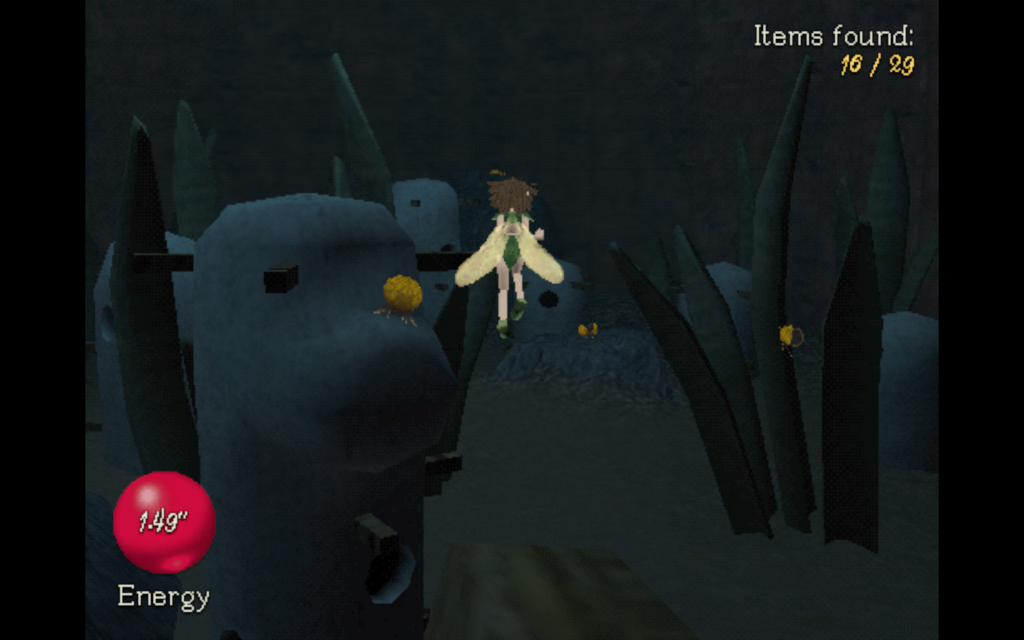
Feydome (itch.io, $0)
It’s too light to make it an official Romhack Thursday post, but it is Thursday, so…. or rather, it was, yesterday, when this was slated to go originally, except Fully Ramblomatic premiered and I figured I should strike while that iron was hot. This iron, after all, is more malleable at lower temperatures.
Alex Zandra on Mastodon, @zandra@mastodon.social, who is @zandravandra on Cohost, put together a list of her favorite Mega Man romhacks that looks pretty interesting.
The games are (in order through the series): Mega Man Speed Bomber, Rollchan No Constancy, Rollchan At The Tokyo Olympics, Mega Man 4 Voyage, Mega Man 5 Double Jumper, and Rockman 6 Spirit of Hackers. The closest I’ve come to playing any of them was Rockman No Constancy, before Roll was put into it. There are lots of hacks that are difficult even to play, so curated lists of them are very useful!
Alex Zandra’s list of Mega Man Romhacks (cohost.org)
So the dust has settled a bit, and now Nick Calendra, Ben “Yahtzee” Croshaw and a number of other people from The Escapist’s video production department have left that company and started Second Wind, fully creator-owned. And Yahtzee has made his first episode of the replacement for the 16-year-old Zero Punctuation, using the name of his blog, Fully Ramblomatic. The episode covers Alan Wake II, and it’s exactly what you’d expect it to be: profane, insightful and full of obscure references, like using the head of H.P. Lovecraft as part of the “lake of mysterious occult wank” that Alan Wake has lept into.
It’s all still Ben Yahtzee, which isn’t entirely to my tastes, but other than a couple of missteps through the years he’s generally been a good egg, or so I’ve been given to understand. I’m on board with things that increases the viability of creator-controlled media at least, so I wish them well.
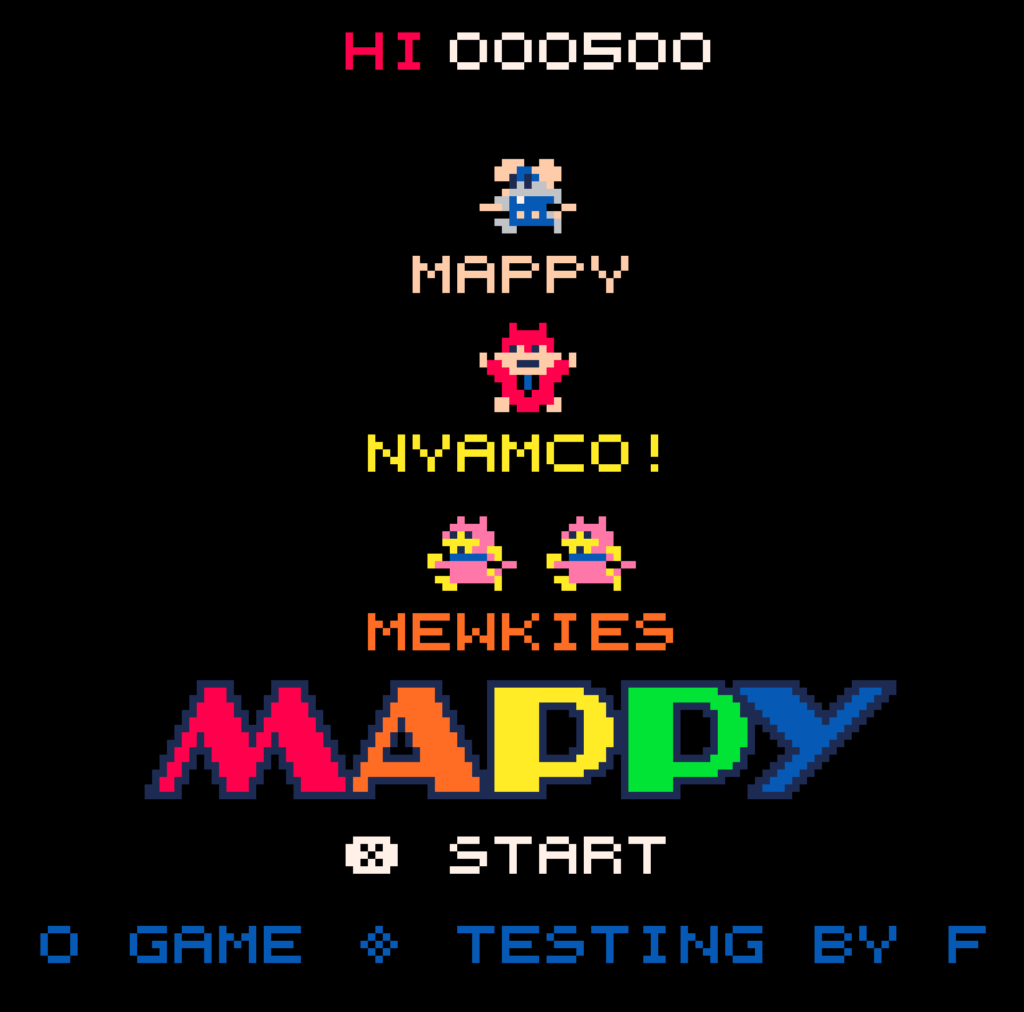
What pushes a game past the notability barrier, that makes it interesting enough for me to post it here? Classic arcade game remakes are always a good sign. Items for the Pico8 fantasy console are also a strong positive factor. These two elements combined well make it a must-post.
Especially when the game is Mappy. A great game from Pac-Man-era Namco, simple rules but, while surprisingly difficult, a little strategy can get you a long way in. Still, true mastery needs a lot more than that.
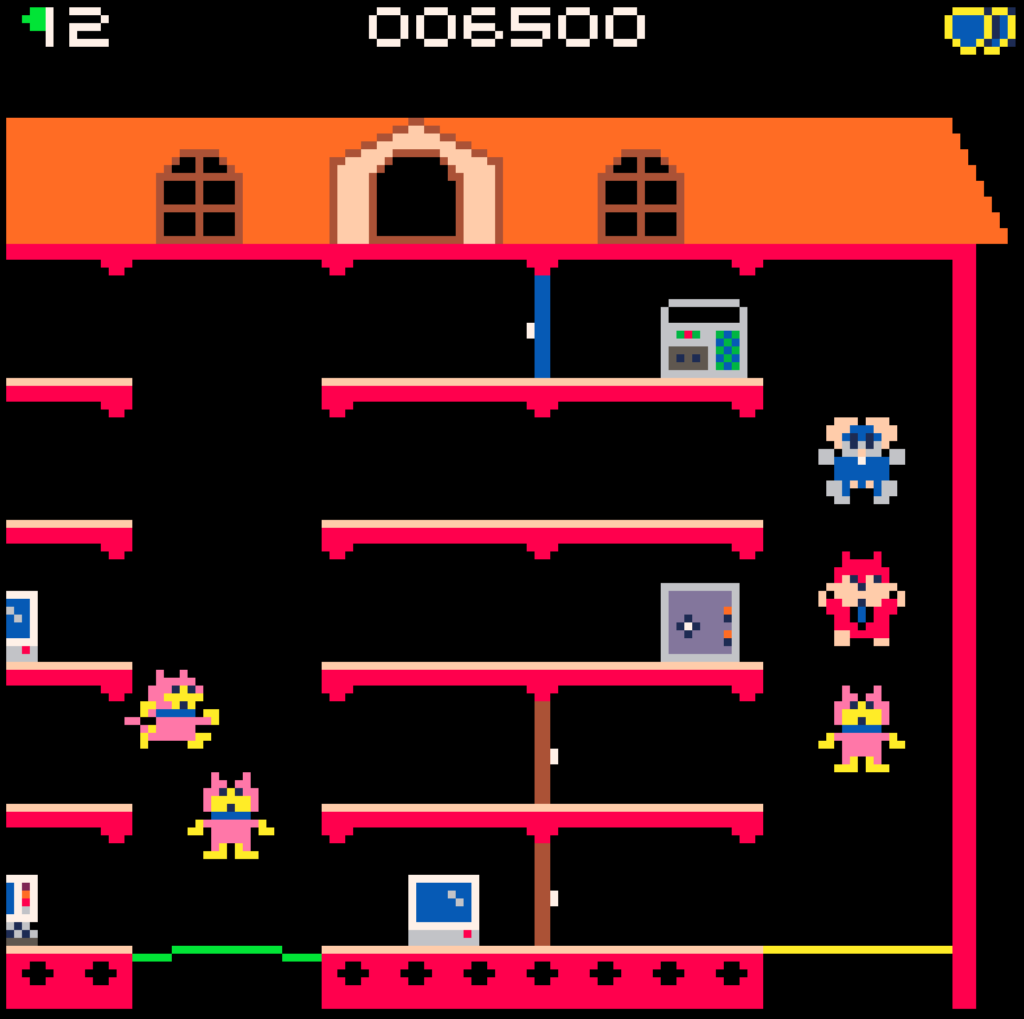
This Pico8 version is a good remake, although quite a bit harder. Guide Mappy of the Micro Police through each mansion, stealing back the ill-gotten gains of kitty-cat gang. Unlike many policepeople, Mappy is an entirely non-violent actor, and actually never arrests anyone; he just takes back their loot. And for their part, while the Mewkies and Goro (“Boss the Big Bit”) do knock Mappy out of they catch him, later media seems to indicate that neither side bears any real antipathy for the other. They’re just doing their jobs.
The thing that makes Mappy unique is its trampolines. While on a trampoline you cannot be hurt by the cats, but three bounces on the same one without stopping causes it to break. When you get off the trampoline it’s easy to get caught unless you use the doors as a defensive tool. Pressing the button (X in this Pico8 version) opens the closest door in front of you-you don’t even have to be near it. It swings out in the direction of its doorknob, and knocks out any cat near it on that side for a few seconds, allowing you to pass by. The light-colored doors also house the powerful Microwave, not here a cooking tool but a multicolored beam that launches out and sweeps cats it hits out of the level for a few needed seconds.
This remake of Mappy restores the Japanese name for Goro, “Nyamco,” a pun on the arcade company’s name with a cat angle: “Nyan” is Japanese onomatopoeia for “meow.” You’ll find that while supposed-boss Nyamco is as aimless as he ever was, wandering each level mostly randomly and hiding behind loot, the Mewkies are tenacious chasers, and here will quickly corner you if you don’t have a good plan. Even with its higher difficulty it’s a lovely port, and it’s free to play too!
Mappy for Pico8 (itch.io,x` $0)
More of my favorites from the first Nextfest of 2023.
Here are the contents, each section is about two minutes in length:
Dice Folk – No Creeps Were Harmed TD – Devil’s Dive – Boomerang Jack – Dystobel – Ugly – Cosmic: A Journey Among Shadows – Lil’ Guardsman – The Master’s Pupil – Ratopia – Rad Survivor – Cardbob
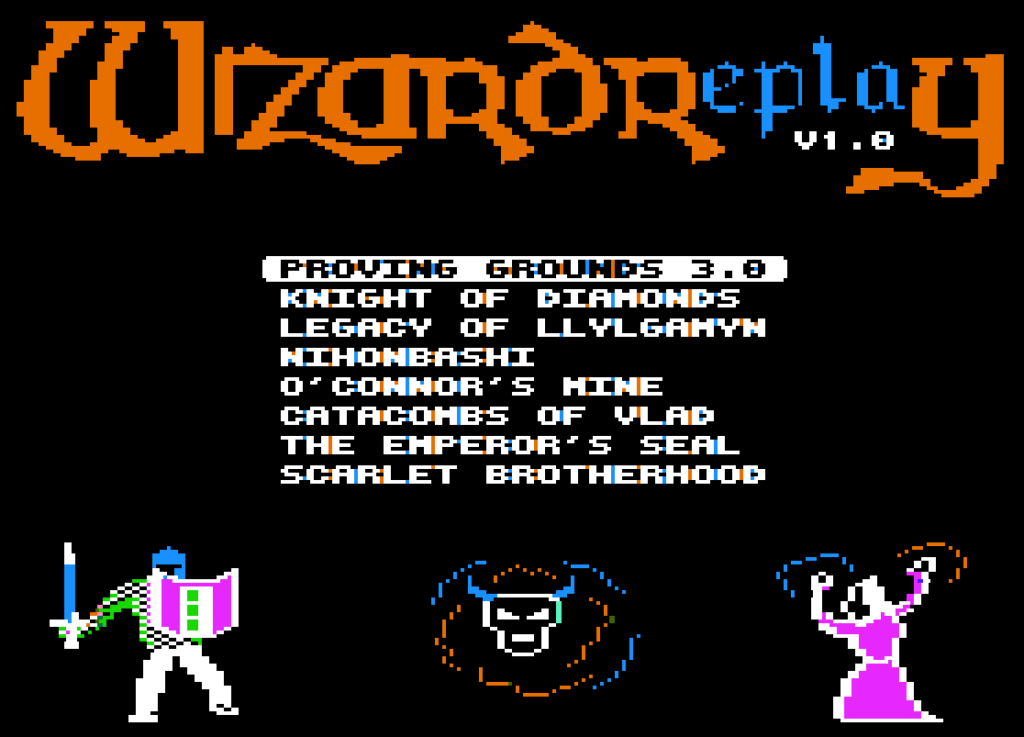
Wizardry used to be the most popular computer game in the world.
It has fallen on hard times recently. Creators SirTech released the terrific Wizardry 8 but then almost immediately closed up. The name is currently owned by a Japanese developer, who make games in the classic style but they’re still quite different, chasing old ghosts instead of trying to adapt the idea for new generations.
A full examination of Wizardry will have to wait for another time, but until then there’s a repackaging of the original Apple II versions available from the Total Replay folks. It’s made to run off of a ProDOS-formatted hard drive, words that themselves form a fearsome incantation, but you can still play it emulated. And should!
It includes an update of the original Proving Grounds of the Mad Overlord, plus the successor scenarios Night of Diamonds and Legacy of Llylgamin, plus five fan-made scenarios. It also includes WizPlus, a character editor, but diehards won’t use that. It’s cheating!
To explain Wizardry in summary, it took the ideas of early Dungeons & Dragons and adapted them to a dungeon exploration simulation with the same kind of theoretical basis. In D&D, if a character dies and there’s no way to revive it, it’s gone: no backsies. And sometimes revivals fail, and the character is gone anyway. And the dungeon in a genuinely treacherous place. If your party wipes, to even try to revive them, you have to create a new party of adventures, take them in, find the deceased party’s corpses in the dungeon, and either use magic to revive them there or drag them back to town to have the Temple of Cant do it.
If this sounds forbidding to current sensibilities, it certainly is! But that’s the point. Because of it, it’s about as close as you can get to traditional RP-gaming as you can get on a computer, even more so that official D&D products. Roguelikes come close, but since you only play as a single character in most of them they still don’t quite fit that electronic bill.
Wizard Replay (Apple II, Internet Archive)